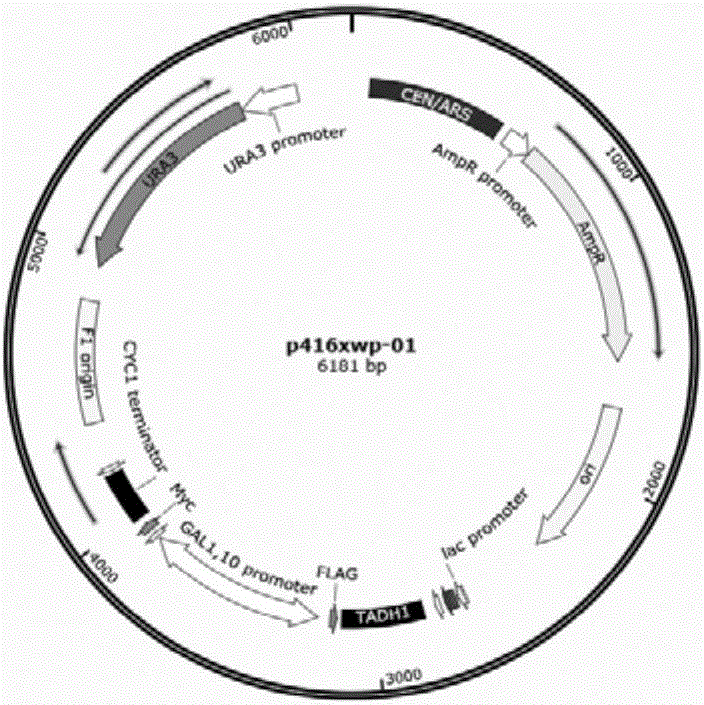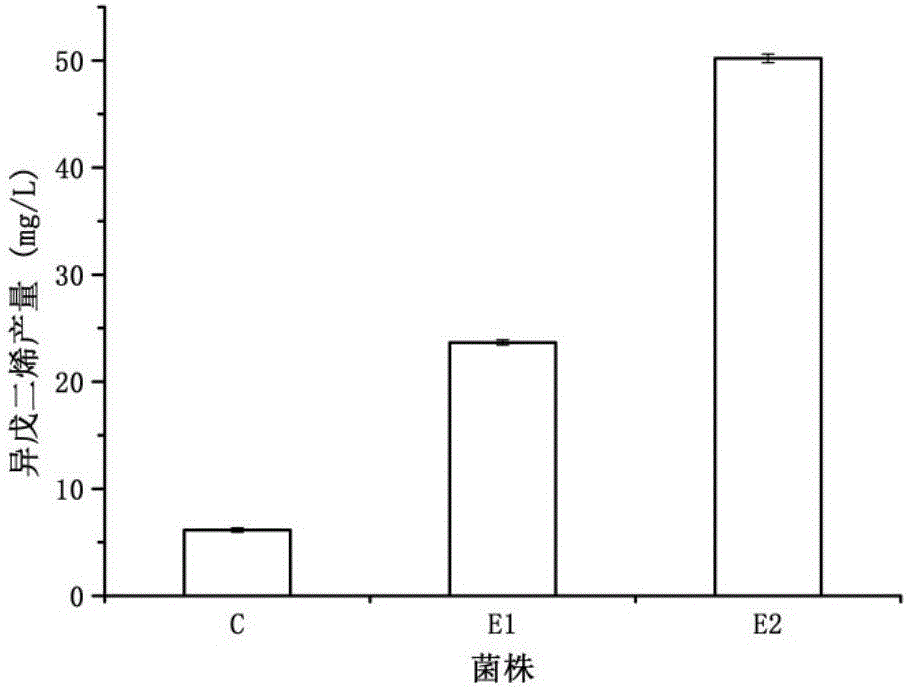Method for improving isoprene synthesis capability of saccharomyces cerevisiae
A technology of Saccharomyces cerevisiae and isoprene, which is applied in the field of bioengineering, can solve problems such as improving the synthesis ability of weak isoprene, and achieve the effects of improving the synthesis ability of isoprene, enhancing the strength, and enhancing the transcription level.
- Summary
- Abstract
- Description
- Claims
- Application Information
AI Technical Summary
Problems solved by technology
Method used
Image
Examples
Embodiment 1
[0047] Example 1: Construction of isoprene synthesis pathway in Saccharomyces cerevisiae
[0048] The isoprene synthase gene from Populus alba was optimized with codon optimization software, and the optimized sequence was artificially synthesized. The optimized IspS was cloned into p416xwp01 plasmid with primers IspS-F(26) and IspS-R(27), and transformed into Saccharomyces cerevisiae to synthesize isoprene.
Embodiment 2
[0049] Example 2: A method for constructing a GAL4 overexpression strain.
[0050] The plasmid PLGL-△GAL1 / 7 / 10-PGAL4-GAL4 used to construct the GAL4 overexpression strain is as follows:
[0051] Using the plasmid PUG6 as a template, the loxp-KanMX-loxp fragment was amplified with primers loxp-F1(30) and loxp-R1(31). Using the plasmid pESC-URA as a template, use primers loxp-F2 (32) and loxp-R2 (33) to amplify the ori fragment, and use primers TADH1-F2 (34) and TCYC1-R2 (35) to amplify the T ADH1 -MCS1-P GAL10 -P GAL1 -MCS2-T CYC1 segment. The three fragments were fused to construct plasmid PMRI-28.
[0052] Using the Saccharomyces cerevisiae BY4741 genome as a template, the upstream 534bp of the GAL1 / 7 / 10 segment was amplified with primers △GAL1 / 7 / 10-UP-F1(22) and △GAL1 / 7 / 10-UP-R1(23) , using primers ΔGAL1 / 7 / 10-DN-F1 (24) and ΔGAL1 / 7 / 10-DN-R1 (25) to amplify the downstream 671bp. The two fragments have homologous sequences, and the two fragments are fused by overlapping...
Embodiment 3
[0062] Example 3: Determination of IspS transcript levels.
[0063] The starting strain (C) and the GAL4 overexpression strain (E1) were cultured in liquid SS-URA medium. During the shake flask fermentation process, 2 mL of fermentation broth was taken respectively at 18 hours, 24 hours, 48 hours and 72 hours.
[0064] Total RNA of each sample was extracted with an RNA extraction kit (Takara). Genomic DNA was removed using a reverse transcription kit (Takara) and reverse transcribed to obtain cDNA. The experimental operation was carried out according to the instructions of the kit.
[0065] Using the ACT1 gene as an internal reference, real-time fluorescent quantitative PCR was performed on IspS to obtain an amplification curve and record the CT value. use 2 -△△CT Relative transcript levels of IspS were calculated.
[0066] Table 1 Relative transcript levels of IspS
[0067]
PUM
 Login to View More
Login to View More Abstract
Description
Claims
Application Information
 Login to View More
Login to View More - R&D Engineer
- R&D Manager
- IP Professional
- Industry Leading Data Capabilities
- Powerful AI technology
- Patent DNA Extraction
Browse by: Latest US Patents, China's latest patents, Technical Efficacy Thesaurus, Application Domain, Technology Topic, Popular Technical Reports.
© 2024 PatSnap. All rights reserved.Legal|Privacy policy|Modern Slavery Act Transparency Statement|Sitemap|About US| Contact US: help@patsnap.com










